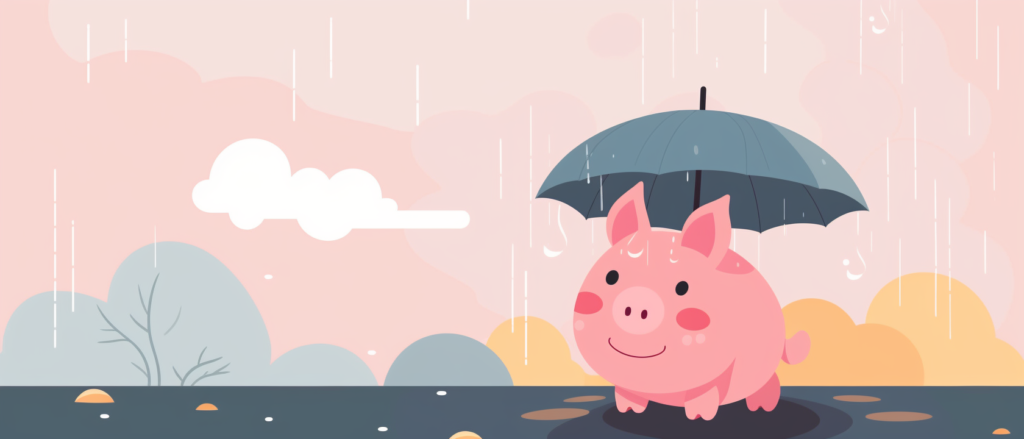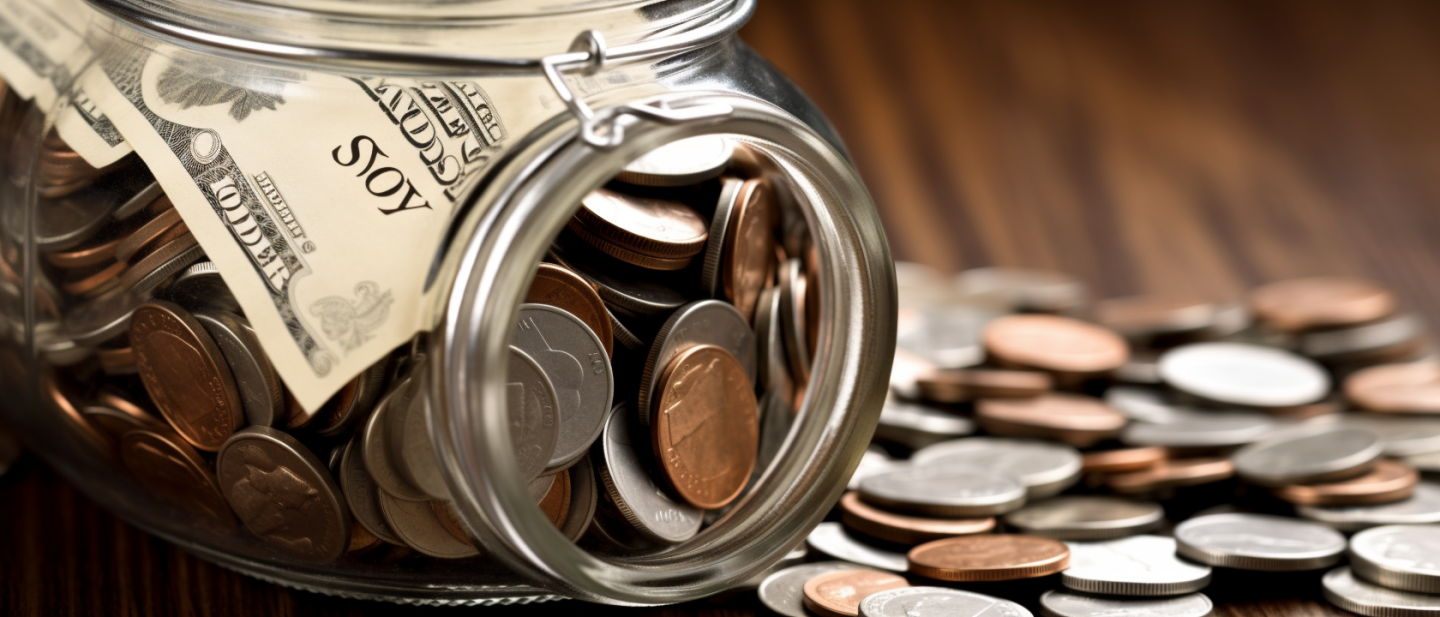
Table of Contents
- A rainy day fund provides a cushion, so you don’t have to turn to high-interest debt to cover life’s unexpected expenses
- It’s different from an emergency fund, which is meant to carry you through a longer-term financial crisis
- An ideal balance for a rainy day fund is anywhere from $500–$2,500, but you should set an initial goal based on what you can realistically save
- High-yield savings or money market accounts are the best places to keep cash for a rainy day
No matter how well you plan, it’s impossible to predict every expense life will throw your way. Home repairs, medical emergencies, appliance breakdowns — the list goes on. These minor inconveniences can become major problems if you don’t have the cash available to cover the cost.
To ensure life’s mishaps don’t derail you financially, it’s wise to keep a small reserve fund designated strictly for emergencies. This “rainy day fund” can help you weather the storm when the unexpected occurs.
Defining the Rainy Day Fund
A rainy day fund is an account with a small amount of cash reserves — usually $500 to $2,500 — meant to pay for small but significant unexpected expenses. Whether it’s a visit to the emergency room or a broken-down vehicle, these costs can throw off your budget and cause financial setbacks if you don’t have cash on hand.
Without a rainy day fund, you may have to push back other financial priorities when these unpredictable expenses arise. At best, you’ll need to tap into cash you had reserved for other purposes. At worst, you have to resort to using credit cards or high-interest loans, both of which cost far more in the long run.
The Need for a Rainy Day Fund
The majority of Americans don’t have sufficient funds stashed away to handle common emergencies. According to the Federal Reserve’s latest “Report on the Economic Well-Being of U.S. Households,” 43% of U.S. adults don’t have enough cash to cover an unexpected expense of $1,000 or more.
Yet, many of life’s emergencies can easily exceed that amount. A visit to the ER averages $2,600 if you’re uninsured, for instance, while replacing your home’s air conditioning unit can cost upwards of $5,000.
When you resort to high-interest loans or credit cards to cover such costs, it becomes that much more difficult to get ahead financially. For example, with a minimum monthly payment of $50, it would take you more than five years to pay off a $2,000 expense on a credit card with a 20% APR, and you’d rack up an extra $1,300 in interest charges along the way.
In contrast, a rainy day fund gives you financial wiggle room to take care of these costs. This brings several key benefits:
- Reduces financial stress: A cushion against unexpected costs can offer stability and mental peace. You may not be able to predict what’s coming, but you can feel confident that you’ll be prepared.
- Restores control: Having cash available allows you to take quick action, providing a sense of empowerment when you face unforeseen challenges.
- Prevents debt accumulation: A rainy day fund helps you avoid resorting to high-interest debts like credit cards or personal loans, which can become unmanageable if you can’t make sufficient payments.
Rainy Day Fund vs. Emergency Fund
Rainy day funds are commonly confused with another important savings tool: the emergency fund. Although they serve similar purposes, these two funds are distinct, and it’s a good idea to save cash in both.
Emergency funds are for much larger financial crises, such as losing a job or getting a divorce. They’re designed to see you through a significant short-term setback, and experts recommend saving anywhere from three months’ to a full year’s worth of expenses. Because you may not need the cash all at once, you can keep it in a less liquid account, such as a certificate of deposit (CD).
A rainy day, fund, on the other hand, is meant to cover the small but common unplanned expenses that often arise in day-to-day life. You must be able to get to this cash quickly, so you should keep it in high-yield savings or money market accounts for easy access.
| Rainy Day Fund | Emergency Fund | |
|---|---|---|
| Savings Goal | $500–$2,500 | 3–12 months of living expenses, depending on your financial situation |
| Purpose | Handling smaller financial inconveniences like emergency travel, car maintenance, or unexpected bills | Designed to cushion life’s bigger financial blows, such as job loss or major home repairs |
| Where to Keep | High-yield savings account or money market account | High-yield savings account, money market account, or certificates of deposit |
Determining the Right Amount for a Rainy Day Fund
Although most experts recommend keeping anywhere from $500 to $2,500 in a rainy day fund, the right amount depends on your circumstances. For instance, renters don’t need to pay for home repairs out of pocket, so they may not need as much cash on hand. A homeowner with two cars and three children, on the other hand, faces more potential unplanned expenses and may want to stow the full $2,500. Consider every potential expense, from car insurance deductibles to older appliances that may need repair, to determine how much you should save.
If you’re starting from scratch, don’t pressure yourself to max out your rainy day fund next month. Set a realistic goal based on how much you can save each month or pay period, then make regular weekly or monthly contributions that will allow you to achieve that goal. Consider automating your savings so you don’t have to think about it.
Once you reach your initial goal, take some time to reevaluate your circumstances and decide if you should save more. If you purchased a car and bought insurance with a $500 deductible, for instance, you might want to add $500 to your rainy day fund.
Optimal Location for a Rainy Day Fund
Besides determining the ideal amount for your rainy day fund, you should also decide on the best place to put your money.
With a rainy day fund, accessibility is paramount. When an emergency arises, you don’t want to get hit with hefty fees for pulling money out of a CD. Still, there are better places to stow your cash than underneath the mattress — ones that provide a small return while allowing you to withdraw money anytime.
Practically speaking, that means a high-yield savings account or money market account. Although these accounts won’t quite keep up with inflation, many online banks and credit unions offer generous yields that can offset the cost of keeping your cash accessible. Just watch out for fees, as some banks will charge you for dropping below a minimum balance or withdrawing funds too frequently.
Above all, be sure your rainy day fund is secure. Only deposit funds in FDIC-insured banks or NCUA-insured credit unions to protect yourself against potential bank failures. This isn’t the place to take risks. Ultimately, you need to be sure your rainy day fund will be there when you need it.
Frequently Asked Questions (FAQs)
What Is A Rainy Day Fund?
A rainy day fund is a financial reserve set aside for unforeseen expenses or emergencies, ensuring you don’t need to dip into long-term savings or incur debt.
How Is A Rainy Day Fund Different From An Emergency Fund?
While both funds are for unexpected costs, a rainy day fund covers smaller, more immediate expenses (like a car repair), whereas an emergency fund is a larger reserve for significant financial hardships (like job loss).
How Much Should I Save In My Rainy Day Fund?
Ideally, a rainy day fund should cover one to two months of living expenses, but the amount can vary based on individual comfort and needs.
Where Should I Keep My Rainy Day Fund?
It’s best to keep this fund in a liquid and accessible account, like a savings account, so you can quickly withdraw without penalties or delays.
How Often Should I Contribute To My Rainy Day Fund?
Regular contributions, such as monthly, are ideal, but any consistent saving habit that helps you reach your goal amount is beneficial.
What Qualifies As A “Rainy Day” Expense?
Rainy day expenses are unforeseen and necessary costs that aren’t regular monthly bills, like fixing a broken appliance or medical expenses not covered by insurance.
















